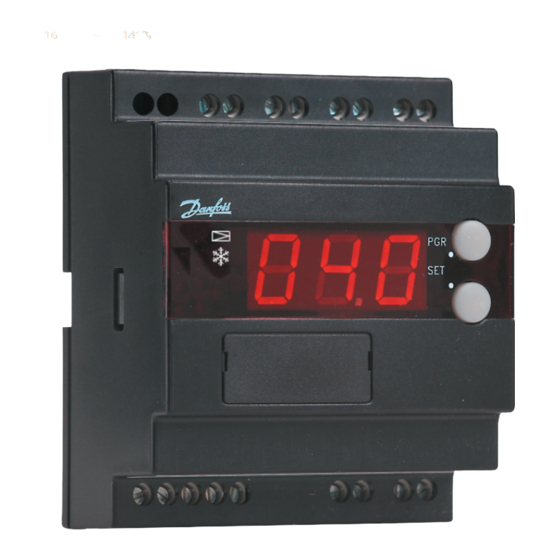
Danfoss EKC 315A Manual
Superheat controller
Hide thumbs
Also See for EKC 315A:
- User manual (17 pages) ,
- Instructions manual (12 pages) ,
- User manual (16 pages)
Advertisement
Table of Contents
- 1 Table of Contents
- 2 Introduction
- 3 Valve Compatibility
- 4 Ordering
- 5 Operating Principle
- 6 Operating the EKC 315A
- 7 Operating the EKC 315A
- 8 Quick Setup Guide
- 9 Survey of Functions, Settings, and Parameters
- 10 Service Parameters for Troubleshooting
- 11 Technical Data
- 12 Wiring Diagram and Terminal Functions
- 13 Troubleshooting
- 14 Appendices
- Download this manual
Advertisement
Table of Contents
Troubleshooting

Summary of Contents for Danfoss EKC 315A
- Page 1 Superheat controller EKC 315A REFRIGERATION AND Manual AIR CONDITIONING...
-
Page 2: Table Of Contents
Introduction ....................................3 Valve compatibility ..................................3 Ordering......................................3 Operating principle ..................................3 Operating the EKC 315A ............................... 4 - 5 Quick Setup Guide ..................................6 Survey of functions, settings, and parameters ......................7 - 10 Service parameters for troubleshooting ..........................11 Technical data .................................... -
Page 3: Introduction
Operation Introduction Superheat control with thermostat function The EKC 315A controller can be applied where there is a need for The superheat is controlled by pressure transmitter P and accurate control of superheat and temperature in refrigeration temperature sensor S2. The temperature is controlled by the... -
Page 4: Operating The Ekc 315A
EKC 315A Industrial Evaporator Controller Operating the EKC 315A The Display The EKC 315A has a three character digital display. Four status LEDs (Light Emitting Diodes) are to the left of the numerals. To the right of the display are two push buttons. -
Page 5: Operating The Ekc 315A
18-20 seconds. To reset to factory default values: 1) Remove the supply voltage to the EKC 315A 2) While pressing both buttons simultaneously, restore power. Factory settings will have been restored USCO.PD.RD0.A1.22 /521U0092 © Danfoss USCO (HMR_MKS), 04-2008... -
Page 6: Quick Setup Guide
Manual EKC 315A Industrial Evaporator Controller Quick Setup Guide NOTE: For most applications, only the below parameters need to be reviewed and possibly changed. For each parameter, record your setting and other pertinent settings if any, in the “Field Settings” column provided in each parameter table on the following pages. After going through the quick start procedure below, it is best to review the complete parameter list to ensure all needed changes have been done for your application. -
Page 7: Survey Of Functions, Settings, And Parameters
This setting is not changed by entering the parameter list, but by pushing both buttons simultaneously, then using the buttons individually to adjust the setpoint up and down (see the section “Operating the EKC 315A. ” ) Differential for thermostat function When temperature is higher than reference plus this user-set differential, 0.2°F... - Page 8 Manual EKC 315A Industrial Evaporator Controller Regulating parameters NOTE: Only a trained Danfoss technician should adjust settings given in the gray blocks. Misadjustment could cause serious system malfunction. Factory Field Description of setting Parameter Minimum Maximum setting setting P: Amplification factor, K Increasing proportional factory Kp leads to larger changes in controller output for a given input (regulation becomes faster).
- Page 9 Manual EKC 315A Industrial Evaporator Controller Miscellaneous parameters Factory Field Description of setting Parameter Minimum Maximum setting setting Define valve and AO (analog output) signal The controller can control 3 types of valves: pulse-width modulation valve AKVA, motorized valve type ICM with ICAD motor-actuator, and discontinued valve type...
- Page 10 Manual EKC 315A Industrial Evaporator Controller Miscellaneous parameters (continued) Factory Field Description of setting Parameter Minimum Maximum setting setting Value of analog output at minimum current (terminals 2 & 5) (only applicable to AKV/A or TQ) -94°F 320°F -31 °F Lower end of temperature or opening degree range that will yield a current (-70°C)
-
Page 11: Service Parameters For Troubleshooting
Manual EKC 315A Industrial Evaporator Controller Service Parameters for Troubleshooting (view only) Description of parameter Parameter Units* Current TQ valve’s (discontinued valve) actuator temperature °F or °C Reference for TQ valve’s (discontinued valve) actuator temperature °F or °C Analog input current signal (terminals 18 & 19) from PLC, etc. -
Page 12: Wiring Diagram And Terminal Functions
Pressure transmitter, type AKS 33 Optional analog 80 VA max load input from PLC etc. Note: Each EKC 315A controller can control a type AKV/A valve or an ICM, AKV or AKVA pulse-width but not both simultaneously. modulation expansion valve Note: controller powers the 24Va.c., max 20W coil... -
Page 13: Troubleshooting
Manual EKC 315A Industrial Evaporator Controller Troubleshooting Failure to regulate after Setup If, after setting up according to the Quick Setup Guide on page 6, the valve will not regulate, the cause may be one of the following: 1. There is no connection (either a closed switch or a jumper wire) between terminals 1 &... -
Page 14: Appendices
This strategy is used in situations where the evaporator to be controlled exceeds the capacity of a single expansion valve. Remember to set parameter o09 in both the EKC 315A and the EKC 347. Appendix 2 The two types of superheat regulation, load-defined control and adaptive control are shown below. - Page 15 Manual EKC 315A Industrial Evaporator Controller USCO.PD.RD0.A1.22 / 521U0092 © Danfoss USCO (HMR_MKS), 04-2008...
- Page 16 Manual EKC 315A Industrial Evaporator Controller Danfoss Inc. · Refrigeration & Air Conditioning Division · 7941 Corporate Drive · Baltimore, MD 21236 Ph 410-931-8250 · Fax 410-931-8256 · E-mail: baltimore@danfoss.com · Internet: www.danfoss.us/Industrial_Refrigeration USCO.PD.RD0.A1.22 / 521U0092 © Danfoss USCO (HMR_MKS), 04-2008...















Need help?
Do you have a question about the EKC 315A and is the answer not in the manual?
Questions and answers